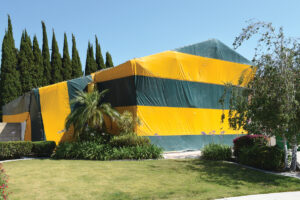
Structural fumigation—tenting a house and piping in chemicals to kill the bugs—is the most effective way to do it. But sulfuryl fluoride, a common chemical used for termite fumigation and the only fumigant approved by the Environmental Protection Agency (EPA) for use in residential structures, is a potent greenhouse gas. A team led by Whiting School PhD candidate Dylan Gaeta used atmospheric observations from the National Oceanic and Atmospheric Administration to show that the large majority of sulfuryl fluoride emissions in North America came from California in 2015–2019. Gaeta, whose team presented its findings at the American Geophysical Union’s annual meeting, shares insights from their study:
Why is the problem concentrated in California?
California’s year-round warm climate is favorable for termite colony growth, both indoors and in nature, so it is very common for buildings there to have termite infestations that require fumigation. In addition, California is the only state that publicly releases a statewide record of sulfuryl fluoride use.

Aside from being a greenhouse gas, is sulfuryl fluoride bad for human health?
The gas is often referred to as a pesticide or an insecticide, but more generally, it is a biocide: It will kill all living organisms that are exposed to it at sufficiently high concentrations for a sufficiently long period of time. That includes humans, pets, plants, and wildlife. The EPA has set an exposure limit of 1 part per million for sulfuryl fluoride,and fumigators must ensure that every room in a fumigated structure falls back below 1 part per million before humans and pets can reenter. There have been several documented cases of inadvertent deaths caused by sulfuryl fluoride fumigations, and the EPA is currently reviewing public health and safety regulations for its use.
What are the climate implications for sulfuryl fluoride use?
Sulfuryl fluoride is a potent greenhouse gas that is entirely human-made, with no significant natural sources. Sulfuryl fluoride was first discovered in ambient air in La Jolla, California, prompting a series of seminal studies. The results were published in 2008–2009, with the main takeaway that sulfuryl fluoride has a much longer atmospheric lifetime than initially thought: 36 (plus or minus 11) years.
With such a long life span in the atmosphere, the global warming potential was revised upward to 7,510 over a 20-year interval. In other words, 1 ton of sulfuryl fluoride traps as much heat in the atmosphere as 7,510 tons of carbon dioxide. After these studies were released, the Intergovernmental Panel on Climate Change added sulfuryl fluoride to its list of greenhouse gases in 2013, and the California Air Resources Board added the chemical to its list of short-lived climate pollutants. However, global emissions of the gas have continued to rise. The gas has been left out of most major greenhouse gas inventories and emissions reductions targets.
What real-world impact do you hope this research will have?
We would like to see sulfuryl fluoride included in future greenhouse gas inventories at the national, state, and local levels.




